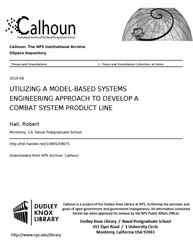File:UTILIZING A MODEL-BASED SYSTEMS ENGINEERING APPROACH TO DEVELOP A COMBAT SYSTEM PRODUCT LINE (IA utilizingamodelb1094559675).pdf

Original file (1,275 × 1,650 pixels, file size: 1.85 MB, MIME type: application/pdf, 98 pages)
Captions
Captions
Summary[edit]
| UTILIZING A MODEL-BASED SYSTEMS ENGINEERING APPROACH TO DEVELOP A COMBAT SYSTEM PRODUCT LINE
( |
||
|---|---|---|
| Author |
Hall, Robert |
|
| Title |
UTILIZING A MODEL-BASED SYSTEMS ENGINEERING APPROACH TO DEVELOP A COMBAT SYSTEM PRODUCT LINE |
|
| Publisher |
Monterey, CA; Naval Postgraduate School |
|
| Description |
Current U.S. Navy combat system suites are ship class dependent. There are a variety of configurations that include sensors, weapons, and system interfaces to accomplish similar goals. The Navy Surface Warfare Center recommends developing combat system architectures utilizing reusable product line components. This recommendation is accomplished by applying model-based systems engineering and product line engineering to develop a combat system architecture with planned reuse of system components. Current U.S. Navy and European combat systems are reviewed as an introduction to the architecture and components of operational systems. Conducting functional decomposition and identifying commonalities of the reviewed combat systems allow for development of a system architecture following the Hatley-Pirbhai modeling framework. The system architecture helps identify system variability, which, in turn, is used to generate orthogonal variability models that are used to design the combat system product line. A product line orthogonal variability model features packaged variants for three proposed combat system tiers representing scalable capabilities. The benefits of a product line engineering approach are validated by a system-level Constructive Product Line Investment Model. This research provides a methodology and cost modeling tool for future combat system design as well as background for further research in combat system product line engineering. Subjects: systems engineering; SE; model-based systems engineering; MBSE; product line engineering; PLE; product line; Combat Systems; Constructive Product Line Investment Model; COPLIMO; Hatley-Pirbhai modeling; orthogonal variability modeling; future combat systems; surface combatant; Aegis |
|
| Language | English | |
| Publication date | June 2018 | |
| Current location |
IA Collections: navalpostgraduateschoollibrary; fedlink |
|
| Accession number |
utilizingamodelb1094559675 |
|
| Source | ||
| Permission (Reusing this file) |
This publication is a work of the U.S. Government as defined in Title 17, United States Code, Section 101. Copyright protection is not available for this work in the United States | |
Licensing[edit]
| Public domainPublic domainfalsefalse |
This work is in the public domain in the United States because it is a work prepared by an officer or employee of the United States Government as part of that person’s official duties under the terms of Title 17, Chapter 1, Section 105 of the US Code.
Note: This only applies to original works of the Federal Government and not to the work of any individual U.S. state, territory, commonwealth, county, municipality, or any other subdivision. This template also does not apply to postage stamp designs published by the United States Postal Service since 1978. (See § 313.6(C)(1) of Compendium of U.S. Copyright Office Practices). It also does not apply to certain US coins; see The US Mint Terms of Use.
|
 | |
| This file has been identified as being free of known restrictions under copyright law, including all related and neighboring rights. | ||
https://creativecommons.org/publicdomain/mark/1.0/PDMCreative Commons Public Domain Mark 1.0falsefalse
File history
Click on a date/time to view the file as it appeared at that time.
| Date/Time | Thumbnail | Dimensions | User | Comment | |
|---|---|---|---|---|---|
| current | 21:14, 25 July 2020 |  | 1,275 × 1,650, 98 pages (1.85 MB) | Fæ (talk | contribs) | FEDLINK - United States Federal Collection utilizingamodelb1094559675 (User talk:Fæ/IA books#Fork8) (batch 1993-2020 #31852) |
You cannot overwrite this file.
File usage on Commons
The following page uses this file:
Metadata
This file contains additional information such as Exif metadata which may have been added by the digital camera, scanner, or software program used to create or digitize it. If the file has been modified from its original state, some details such as the timestamp may not fully reflect those of the original file. The timestamp is only as accurate as the clock in the camera, and it may be completely wrong.
| Short title | UTILIZING A MODEL-BASED SYSTEMS ENGINEERING APPROACH TO DEVELOP A COMBAT SYSTEM PRODUCT LINE |
|---|---|
| Author | Hall, Robert |
| Keywords |
|
| Software used | Hall, Robert |
| Conversion program | Microsoft® Word 2016 |
| Encrypted | no |
| Page size |
|
| Version of PDF format | 1.4 |

